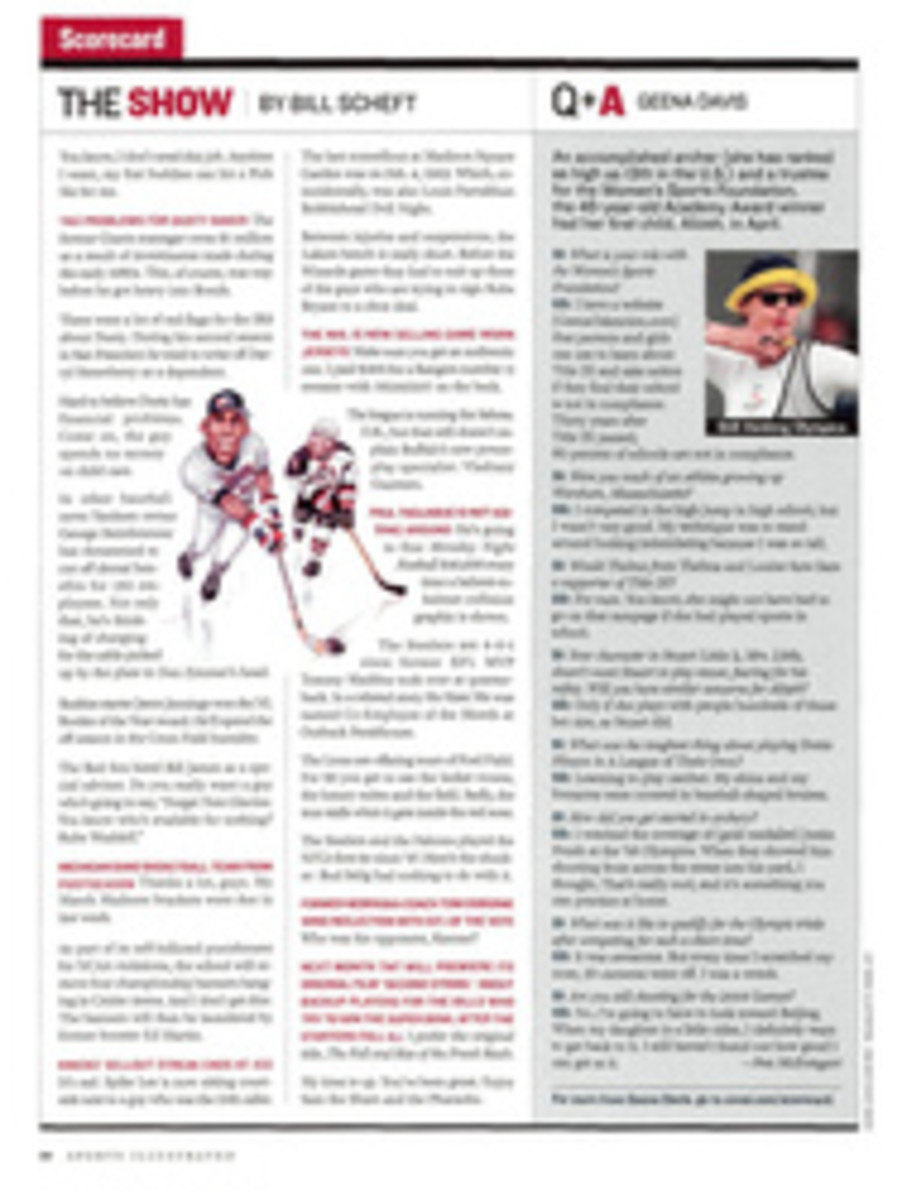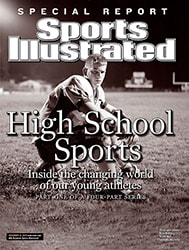
The High School Athlete
Valley Falls gave the Big Reds a real send-off, lining the sidewalks from one end of Main Street to the other to cheer the red-and-white bus on its way. The school band, one hundred strong, led the way. "Bring it back, gang," Petey shouted. "We'll be waiting up Saturday night!" Then they were on their way, singing and cheering....—From Pitchers' Duel, A Chip Hilton Sports Story, by Clair Bee
The numbers—and what do sports train us to trust more than numbers?—tell us that high school athletics have never been healthier. Roughly four million boys and three million girls, more than ever before, participate in one or more of some 50 athletic endeavors before kiting off to the rest of their lives. If we believe that nothing is worth doing unless it's done well, sports justify a place in our secondary schools many times over, for kids today seem to have at their disposal every resource, from weight rooms to legions of assistant coaches to a full calendar of competition, to help them become as good as they desire.
But we're not, alas, in Valley Falls anymore. The win-at-all-costs coaches and preprofessional priorities commonplace in college sports have seeped into grades 12, 11, 10 and below. So-called travel teams have toppled Chip Hilton as an adolescent icon, replacing him with Conrad Hilton. As coaches demand year-round proof of dedication, kids spend a greater and greater proportion of time practicing rather than playing, and many state high school federations, which once enforced strict rules on summer activity, throw up their hands, sometimes eliminating those rules altogether.
If there's a common element to what's happening in high school sports, it's a disconnection from community, a nationwide trend in various aspects of American life that Harvard professor Robert Putnam laid out in his 2000 book about social isolation, Bowling Alone. It's no longer enough to play for the greater glory of Valley Falls, as your older siblings and parents did. Nor is it enough to drift leisurely from sport to in-season sport. The National Federation of State High School Associations doesn't track how many high schoolers play a single sport as opposed to two or three, but no one involved in youth sports disputes that there's a marked trend toward specialization. Dr. Lyle Micheli, executive director of the Sports Medicine Clinic at Boston Children's Hospital, says he sees many more instances of overuse injuries, such as tendinitis and stress fractures, than of acute traumatic injuries like ankle sprains, where even 10 years ago the reverse was true. "Overuse injuries are common in individual sports like gymnastics and figure skating and tennis," Micheli says. "But they're becoming more of a factor in team sports because the sports organizations and coaches are saying, 'If you're really serious about soccer, you shouldn't be playing lacrosse in the spring.'"
In some towns cheerleading squads have vanished because so many girls have left the sidelines to get in the game. And while that's hardly something to lament, another gift of Title IX, the college scholarship, has led girls to become as susceptible as boys to year-round specialization, even as pioneers like soccer's Kristine Lilly and softball's Dot Richardson advise girls to play the field as long as they can.
Coaches recruit across district lines, often mocking the spirit, if not the letter, of rules banning the practice. California law explicitly prohibits transfers for athletic purposes, yet since 1994 that state has also permitted open enrollment—and so the 529 schools in the California Interscholastic Federation's Southern Section report that, between September '99 and December 2001, nearly 3,800 kids pulled on the uniform of a different school without changing their address of record. Sometimes teams even reach across national borders for their ringers: Tucson's Amphitheater High did so to get nine Mexican baseball players in '98; Modesto (Calif.) Christian High did the same to land two English basketball players, who led the school to a 2001 state title game.
Nothing flouts traditional standards of community more than travel teams, which rarely have any formal connection to a local high school. With names that sound like escort services (Gold, Elite, Premier), they serve as catch basins for the most driven athletes from a region, not a town or neighborhood, and go off to play rivals far beyond the crosstown high school. Kids who are forced to choose between a high school team and a travel team often go with the travel team, because that's where the college recruiters look. Small wonder high school coaches, fearful of losing their best players, cave in to kids who want to play on travel teams, even during the high school season. Chicago's Catholic League has long offered ice hockey, but participation has plunged as travel teams have proliferated.
While extensive travel is still largely a summertime phenomenon, secondary schools that can do so are putting together national schedules for their basketball teams, like the one Akron St. Vincent—St. Mary High will play this season with its NBA-ready forward, LeBron James. "It's all about the kids," a St. Vincent—St. Mary official said, straight-faced, after the school announced the Fighting Irish's plan to play arenas in Philadelphia; Chapel Hill, N.C.; and Dayton and Columbus, Ohio. The promoter booking the dates is billing it as the Scholastic Fantastic LeBron James Tour.
As he watches talented classmates pursue sports with a more and more mercenary purpose, it's harder for the typical high school kid to muster the school spirit that marked the Clair Bee era. Mount Carmel, a private school in a misbegotten neighborhood on Chicago's lakefront, would probably no longer exist if not for sports. But because the school has produced such professionals as Chris Chelios of the Detroit Red Wings, Donovan McNabb of the Philadelphia Eagles and Antoine Walker of the Boston Celtics, wannabes make the one-or two-hour round-trip commute from the suburbs.
Indeed, it's often parents who urge kids to cast aside a second or third sport, in hopes of the financial windfall of a scholarship. While this isn't a betrayal of community per se, it's a centrifugal urge that entails setting one's sights on some distant cynosure of celebrity and wealth, and leaving the humble old neighborhood behind. Wisconsin athletic director Pat Richter, a three-year, three-sport letterman with the Badgers (1960, '61 and '62) who played nine seasons in the NFL, calls this the brass-ring theory. According to the NCAA not even one in 330 high school athletes will land a college grant-in-aid.
These changes are taking their greatest toll on baseball, that languid American pastime we still associate with community. When Cincinnati Moeller High baseball coach Mike Cameron was developing such major leaguers as Buddy Bell, Barry Larkin and Ken Griffey Jr., he usually had 90 kids try out for the team. In recent seasons he's gotten half that many, and those who do make the team rarely spend their summers playing sandlot ball. The decline in baseball coincides with the boom in soccer, whose coaches expect kids to begin travel-team play just as ballplayers report.
The temptation of a scholarship drives a lot of families," says one father, whose twin boys each play three sports at a small high school in Vermont. "My sons enjoy the renaissance sports experience I cherished as a kid, but it could cost them the opportunity to play a varsity college sport. I guess that's the price of our competitive 'evolution of the species.'" Even nonscholarship Ivy League and Division III schools—which once celebrated well-roundedness as a virtue—are encouraging the trend toward specialization. "Despite support for the notion of the three-sport athlete, many colleges aren't looking for the well-rounded student anymore, but the well-rounded class," says Dan Doyle, author of the forthcoming Encyclopedia of Sports Parenting. "That means X number of male soccer players, X number of female softball players, etc."
So travel-team coaches thrust contracts in front of nine-year-old girls, asking them to pledge to put soccer ahead of every other sporting pursuit. The girls sign them, with an approving nod from mom and dad. "You see these parents who want their kids to be champions but want it to be a stress-free, enjoyable process," says Caroline Silby, a sports psychologist based in Washington, D.C. "That's not possible. Emotionally, what a child needs and a child champion needs is the same."
During the months he spent following the football team at Odessa (Texas) Permian High for his 1990 book Friday Night Lights, author H.G. Bissinger heard cautionary words that haunted him throughout his season there. They came from a father who saw, Bissinger writes, "the irresistible allure of high school sports, but he also saw the inevitable danger of adults' living vicariously through their young. And he knew of no candle that burned out more quickly than that of the high school athlete."
The brief transit of the schoolboy idol is a bittersweet archetype of American culture, the stuff of Springsteen songs and Updike novels. Yet we ask these athletes to come alight sooner, and burn brighter, than ever. Over the next month SI will feature four snapshots of where high school sports stand today, for better or worse. This week you'll meet two boys from Louisville, both with the chops to excel at three sports and the will to ignore the siren song of specialization. Next week we'll take you to Bradenton, Fla., to the campus of a private academy for serious jocks, set up by International Management Group, much like the New York City high school that trains singers and dancers and was the inspiration for the movie Fame. Then we'll visit Indiana, once home to Hoosier Hysteria, but where high school basketball is no longer packing gyms or knitting together the state's far-flung counties. Finally we'll drop in on a 96-year-old Thanksgiving football rivalry in greater St. Louis, where high school teams still play for school and community.
If Chip Hilton's Valley Falls is our Eden, places like Modesto Christian and Akron St. Vincent—St. Mary are outside the gates. But even at schools untouched by scandal or sellout, there's less singing and cheering, fewer bands and "real send-offs." Classmates no longer wait up for the Big Reds boys' varsity to return on Saturday night, if only because so many have practices of their own on Sunday morning, that brass ring in their sights. To answer the question of whether we believe high school to be a precious interval in a young life or some Scholastic Fantastic stopover on the way to the Show is to learn a lot about who we are.
If it's true that by our children you shall know us, high school sports implicate us as a dedicated, focused, proudly self-reliant people, or an obsessed, blinkered, hopelessly atomized society—take your pick. But one thing is certain. In spite of all the trappings of tradition, notwithstanding the dads in the stands with three-letter sweaters in their closets, we are not who we once were.
B/W PHOTO: PHOTOGRAPH BY LYNN JOHNSON [COVER] SPECIAL REPORT High School Sports Inside the changing world of our young athletes PART ONE OF A FOUR-PART SERIES Three-sport athlete Brian Brohm, Trinity High, Louisville,
KentuckyB/W PHOTO: PHOTOGRAPHS BY LYNN JOHNSON THE WORD Some things are still done the old-fashioned way, such as Trinity High coaches' giving halftime instructions without high-tech visual aids.TWO B/W PHOTOS: PHOTOGRAPHS BY LYNN JOHNSON
The brief transit of the schoolboy idol is a bittersweet archetype of American culture.
The lure of a scholarship has led girls to become as susceptible as boys to specialization.

